Remembering Governor Barnes
British Governor Edward Barnes (1824-31) who was convinced that what Ceylon needed was "first roads, second roads and third roads" was remembered by the erection of a bronze statue in front of Governor's House (later King's House, Queen's House and now President's House) in Fort, on June 18, 1847. Governor Barnes believed that the country needed roads and not forts and diverted all labour and available revenue to building roads without which "we can never be said to have secure possession of the country nor can it commercially improve.” During his term of office he connected Colombo with every town in the island and linked Kandy with every coastal town. He used compulsory labour for a fortnight from peasants who held their lands from service tenure and the skills of military engineers to build the roads. He planned the network of roads with Major Thomas Skinner. The Kelani Ganga was spanned by a bridge of boats, the Maha Oya by a bridge at Mawanella and the Mahaweli Ganga by a satinwood bridge at Peradeniya which boasted a single arch 205 feet long.
A man who wanted to live in style, he built residences for the Governor in Nuwara Eliya (Barnes Hall) and in Kandy (the Pavilion), improved the country residence at Mount Lavinia, and established resthouses at Ambepussa and Ragama. It was largely due to his efforts that coffee plantations were established in the hill country. He opened Gannoruwa Estate (later it became part of the Peradeniya Gardens) himself and encouraged Europeans by granting land up to 4,000 acres free from tax for five years. He did not neglect copra, coconut oil, fibre, tobacco and pepper either. Major Skinner wrote that when his statue was opened in 1847, it was treated by the peasantry as an object of veneration. "On its erection natives from all districts flocked to it; during the night offerings were so frequently left at its base that we were obliged to enclose it with a railing to prevent it being converted into an idol," he wrote. The first Royal Botanical Gardens Although the first Botanical Gardens had been established at Peliyagoda adjoining the Kelani Ganga in 1800, it was on June 12, 1812 that the Government decided to establish a Royal Botanical Garden. By this time the Gardens had been transferred to Slave Island where the Royal Botanical Garden was established in August 1812. The location was where presently Kew Road runs. W. Kerr was the first Superintendent of the Gardens.
Following floods, in 1813 the Gardens were transferred to Kalutara when 600 acres of a sugarcane estate were converted. In 1821 the Gardens were transferred to Peradeniya. Alexander Moon had taken over as Superintendent following Kerr's death in 1817. The mile long Gardens occupied an area of 143 acres lying 1,550 feet above sea level. The Gardens are situated within a loop made by the Mahaweli Ganga. George Gardner, a Brazillian traveller who took over in 1840 opened up the land and built roads. He travelled around the country collecting plants. He died of apoplexy in Nuwara Eliya in 1847 when he was just 37. The golden era of the Gardens began in 1847 when Henry Kendrick Thwaites (37) took over and started beautifying the Gardens and introducing new products. In 1860 Hakgala Gardens near Nuwara Eliya were chosen to grow cinchona (quinine) plants brought from Peru. Situated alongside the Hakgala Mountains which all 5,600 feet above sea level, and covers around 550 acres. In 1876 the first rubber seeds were brought in from the Amazon Valley (Brazil) and planted at the Henaratgoda (Gampaha) Botanical Gardens which came to be used as experimental gardens for low-country products.
|
|||||||
Copyright © 2006 Wijeya Newspapers
Ltd. All rights reserved. |


